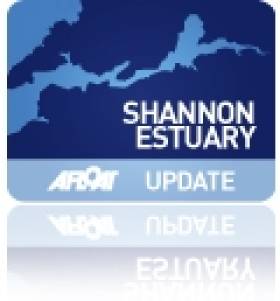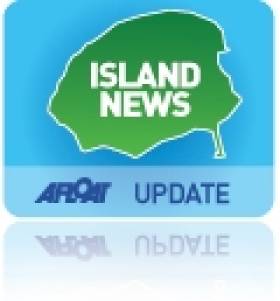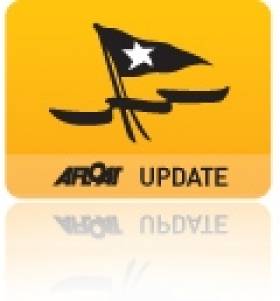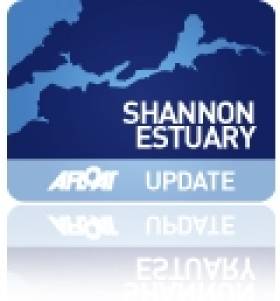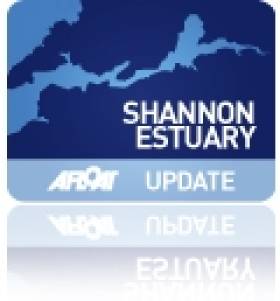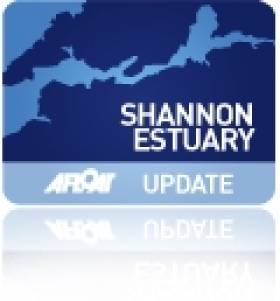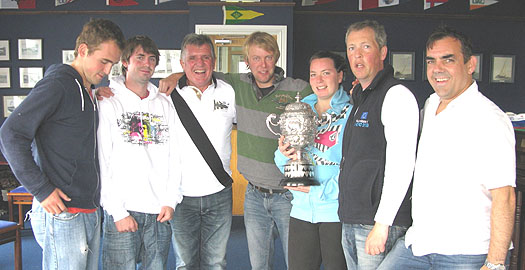Displaying items by tag: Shannon Estuary
President Michael D Higgins has been in Limerick this week in honour of its status as Ireland's City of Culture 2014. In addition to other events, a highlight was his award of the Freedom of Limerick, something very special to him as he was born in the Shannonside port.
Ireland's Head of State is keenly aware of the Shannon and Limerick's rich maritime heritage, and he and his party spent almost an hour visiting the "Naumachia in the Cathedral", the exhibition in St Mary's Cathedral of the CityOne sailing dinghies built by trainees with the Ilen Boatbuilding School in the city.
The Ilen Boatbuilding School has several significant cultural aspects, as it was brought into being by Limerick designer Gary MacMahon and Brother Anthony Keane of Glenstal Abbey initially to teach boat-building skills by restoring the 1926-built 56ft ketch Ilen, which was designed by noted Shannon Estuary ocean voyager and adventurer Conor O'Brien.
But then as the work of the school developed, it took on the project of also building 23ft boats of the traditional Shannon gandelow type, specialized craft which evolved over the centuries to deal with the challenges of using the shallow and muddy waters of the Shannon Estuary with its exceptional tidal range.
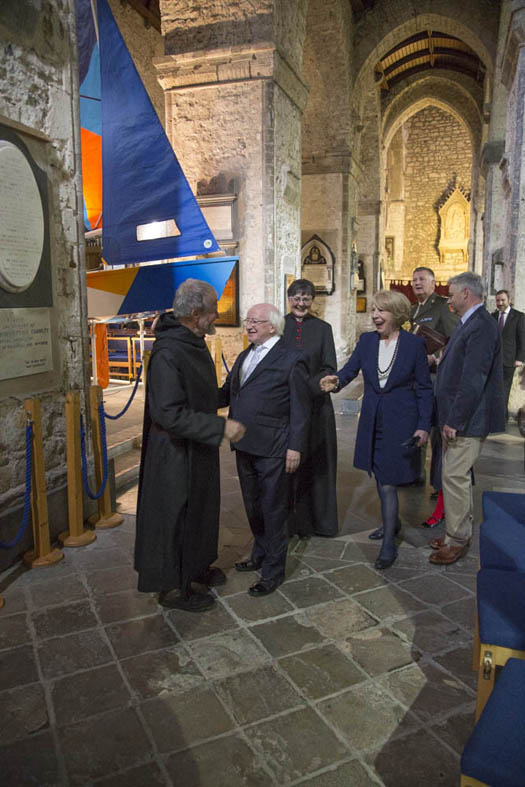
The President of Ireland is welcomed to the Naumachia in the Cathedral by Brother Anthony Keane of Glenstal Abbey. Also foreground are the Dean of Limerick the Very Reverend Sandra Bragnell, Mrs Sabina Higgins, and Gary MacMahon of Ilen Boatbuilding School.
It was the first time any new gandelows had been built in well over thirty years. This project was then further developed to build the CityOne Sailing Dinghies specifically for Limerick use, the unique design of these boats being drawn by naval architect Theo Rye to a detailed Limerick specification. With the new dinghies planned for completion at the height of Limerick's year as City of Culture, a CityOne International Graphic Arts Competition was also launched to create innovative ideas for the colour layouts on the sails and the hulls of the boats. It attracted 61 entries worldwide, and the four selected designs were from graphic artists in Kenya, Ireland Portugal and Texas.

Participants in the Ilen School at the Cathedral included (left to right) Robert Smalle. Tony Broe, Liam O'Donoghue, James Madigan (Ilen School Instructor), Michael Grimes and Gary Wilmott.
It was the CityOne dinghies with their striking colour schemes which formed the centrepiece of the Naumachia in the Cathedral. But there were other exhibits linked to the many aspects of the Ilen School's work too, and in addition to meeting the boatbuilders and crews that sail the CityOnes, the President also met the "Gandelow Gang", who are drawn from the Limerick area both to make up the building teams for gandelows and CityOnes alike, and to row the gandelows in competition and traditional boat gatherings at home and abroad.
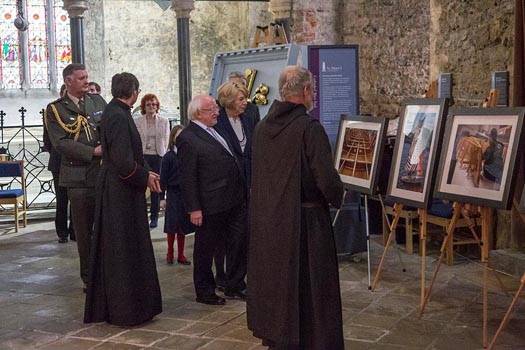
The Presidential party inspect the exhibits detailing the work of the Ilen School
In concluding his speech, the President summed up the mood of the day:
"I very much want to thank everyone involved in staging this exhibition here in this magnificent 12th Century building. What a great tribute it is to those who put all the original stones in place, that there is something new of the human spirit and craft being exhibited here. These boat builders, they are consummate craftsmen.
The international design dimension to the CityOne project is to be highly commended, and it is such a pleasure to be here with you today. I am delighted that the Ilen School project is part of the Limerick City of Culture. Isn't it wonderful that these skills are being passed down and developed, so that more and more people can take part, and for the community to see such inspiring craft?"
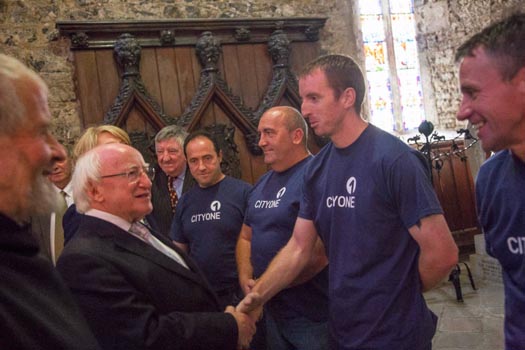
The President meets members of the Gandelow Gang and the Ilen Boatbuilding School including (left to right) James Madigan, Michael Grimes, Gary Wilmott and Tony Broe.
#scatteryisland Brian Ború's 10th century invasion of the monastic settlement of Scattery Island in County Clare and the subsequent killing of the Viking King of Limerick and his two sons will be recreated this weekend.
The Scattery Island Festival, which gets underway tomorrow morning and continues through Sunday, also features guided walks, lectures, music and song, and marine activities celebrating the island's association with St. Senan, the Vikings, Brian Ború, the Spanish Armada and later as a defence outpost for the British.
Uninhabited since 1979, Scattery Island - also known as Inish Cathaigh - is located approximately one mile from Kilrush in the Shannon Estuary and is home to a monastery founded in the early 6th century by St. Senan. The island features the ruins of six churches and one of the highest Round Towers in Ireland at 120 ft. high.
The re-enactment of the raid on the island by Brian Ború and his the Dál Cais army is the main event of the Scattery Island Festival, which is part of the national Brian Boru Programme and coincides with the millennial anniversary of Ború's death at the Battle of Clontarf in 1014.
Academics and historians have for many years argued whether or not Ború broke sanctuary by killing on church land as he sought revenge for the murder by King Ivar of his older brother and King of Munster, Mahon. Most agree however, that the incident consolidated Brian's position as Mahon's successor and helped him in his quest to become High King of Ireland.
Dr. Catherine Swift, Course Director, Irish Studies Mary Immaculate College explained: "The Annals of Inisfallen state that Ímar, king of the foreigners, and his two sons, were killed on Inis Cathaig by Brian, son of Cennétig in 977AD. In an account given in the Annals of Loch Cé meanwhile, Brian sees a vision of St Senán condemning him for breaking sanctuary by killing on church land which is taken to be this incident. Whatever one's opinion is of the manner in which the Norse King was slain, it is clear that his death paved the way for Brian to enjoy unchallenged rule over his home Province of Munster."
Rita McCarthy of the Scattery Island Heritage & Tourism Group said the re-enactment will be the focal point of this year's Festival, the theme of which is 'Invade Scattery'.
Also taking place during the course of the weekend will be a Ceremony of Remembrance for past inhabitants of the island, a Curragh Race, Music and Song with Inis Cathaigh Comhaltas, guided tours of the island by the OPW, talks on Scattery Island's environment and history, a Treasure Hunt for children, and tours to the Napoleonic Battery.
Ms. McCarhy continued: "We are inviting former island inhabitants and anyone with a connection with Scattery or indeed, its rich history to join us this weekend. Last year's inaugural festival, held as part of the Gathering Ireland initiative, proved to be a huge success with more than 5,000 people travelling to the island. This has helped to raise the profile of what has for many years been one of Ireland's least known monastic settlements."
The Scattery Island Festival is part-funded under the Community Tourism Diaspora Fund, operated locally by Clare County Council, IPB and Failte Ireland. For more visit www.brianborumillennium.ie, see Facebook (Scattery Island/Kilrush Gathering), or contact Rita McCarthy of the Scattery Island Heritage and Tourism Group on 087-9731162 / [email protected].
#cityone – The Ilen School CityOne Design Competition invites designers to submit designs for the sails and hull of a new CityOne performance sailing dinghy. Four of these CityOne dinghies are currently under construction through an innovative social educational programme in Limerick City.
As Afloat reported previously, The CityOne dinghy is a new performance dinghy, developed by the Ilen School and designed by naval architect Theo Rye as a legacy project of Limerick City of Culture 2014.
This exciting and challenging competition is open to all designers and high levels of creative freedom are encouraged for the task of designing a concept for application to the hull and sails.
Submissions must be sent by email to [email protected] There is no entry fee.
Three designs will be chosen by a judging panel and each single participant and group design chosen will receive €500* and enjoy the opportunity of seeing their designs creatively applied to the City One sail and hull before they take to the water for racing on the River Shannon, Limerick. The judging panel may also award additional non-monetary, special mentions.
Closing date for submissions Friday 25th July 2014. More on this on the City One competition page here.
#ScatteryIsland – Brian Ború's 10th century invasion of the monastic settlement of Scattery Island and the subsequent killing of the Viking King of Limerick and his two sons will be recreated in County Clare later this month.
The Scattery Island Festival on July 26th-27th also features guided walks, lectures, music and song, and marine activities celebrating the island's association with St. Senan, the Vikings, Brian Ború, the Spanish Armada and later as a defence outpost for the British.
Uninhabited since 1979, Scattery Island - also known as Inish Cathaigh - is located approximately one mile from Kilrush in the Shannon Estuary and is home to a monastery founded in the early 6th century by St. Senan. The island features the ruins of six churches and one of the highest Round Towers in Ireland at 120 ft. high.
The re-enactment of the raid on the island by Brian Ború and his the Dál Cais army is the main event of the upcoming Scattery Island Festival, which is part of the national Brian Boru Programme and coincides with the millennial anniversary of Ború's death at the Battle of Clontarf in 1014.
Academics and historians have for many years argued whether or not Ború broke sanctuary by killing on church land as he sought revenge for the murder by King Ivar of his older brother and King of Munster, Mahon. Most agree however, that the incident consolidated Brian's position as Mahon's successor and helped him in his quest to become High King of Ireland.
Dr. Catherine Swift, Course Director, Irish Studies Mary Immaculate College explained: "The Annals of Inisfallen state that Ímar, king of the foreigners, and his two sons, were killed on Inis Cathaig by Brian, son of Cennétig in 977AD. In an account given in the Annals of Loch Cé meanwhile, Brian sees a vision of St Senán condemning him for breaking sanctuary by killing on church land which is taken to be this incident. Whatever one's opinion is of the manner in which the Norse King was slain, it is clear that his death paved the way for Brian to enjoy unchallenged rule over his home Province of Munster."
Rita McCarthy of the Scattery Island Heritage & Tourism Group said the re-enactment will be the focal point of this year's Festival, the theme of which is 'Invade Scattery'.
Also taking place during the course of the weekend will be a Ceremony of Remembrance for past inhabitants of the island, a Curragh Race, Music and Song with Inis Cathaigh Comhaltas, guided tours of the island by the OPW, talks on Scattery Island's environment and history, a Treasure Hunt for children, and tours to the Napoleonic Battery.
Ms. McCarhy continued: "We are inviting former island inhabitants and anyone with a connection with Scattery or indeed, its rich history to join us on the weekend of July 26-27th. Last year's inaugural festival, held as part of the Gathering Ireland initiative, proved to be a huge success with more than 5,000 people travelling to the island. This has helped to raise the profile of what has for many years been one of Ireland's least known monastic settlements."
The Scattery Island Festival on July 26th-27th is part-funded under the Community Tourism Diaspora Fund, operated locally by Clare County Council, IPB and Failte Ireland. For more visit www.brianborumillennium.ie, see Facebook (Scattery Island/Kilrush Gathering), or contact Rita McCarthy of the Scattery Island Heritage and Tourism Group on 087-9731162 / [email protected].
#rdirl – A father and son duo from Listowel in County Kerry are taking on the double-handed challenge in this year's Round Ireland Yacht Race. The pair Derek Dillon and son Conor, a 19–year–old Univesity of Limerick student, will race the family Dehler 34 'Big Deal' that is based on the Shannon Estuary.
The Foynes Yacht Club pairing have been racing together inshore for over ten years, and have competed at numerous ICRA's, Cork Weeks and Calves Weeks. The pair are sponsored by leading marine supplier, Union Chandlery.
They recently made the move into offshore racing, enjoying recent success in multiple ISORA Qualifying races.
'We look forward to the competitive adventure associated with doing such an endurance race, double- handed', father Derek told Afloat.ie
The pair also plan to compete in the Volvo Cork Week double-handed and compete fully-crewed in Cork Dry Gin Calves Week, in which they have finished first in class in the past two consecutive years.
#foynes – At Foynes Yacht Club on the Shannon Estuary this coming bank holiday weekend the Munster Mermaid championships will take place writes Gerry Ryan of Foynes Yacht Club
This event will be run over two days, Saturday and Sunday, and Officer-of-the-day, Liam Madden has two days of spectacular racing planned on the Shannon estuary.
On Saturday two races will take place east of Foynes Island in an Olympic triangular course, and on Sunday one race is scheduled in Foynes harbour, so that the public can view this spectacular sport.
A total of twelve boats will be competing over the two days, with seven coming from the east coast and the remainder from FYC.
Class captain, Darragh McCormack is hoping for magnificent weather and competitive racing for the event.
This year the Mermaid's will be joined by our friend's from Kildysart, will be sailing currachs to Cooleen Point for the festivities. They will also be racing in the harbour as part of the Foynes Irish Coffee festival.
Fixtures for the month of June at Foynes: On all Wednesday's in June the summer league will take place. Saturday 14, Foynes to Fenit race. Saturday 21 cruise and Bar-b-que. Saturday 28 Foynes to Cappa.
#shannonestuary – On Sunday last at Foynes Yacht Club on the Shannon Estuary, Commodore's Day was held with a superb turnout of member's and the public to make the day one of the best in the annals of the club writes Gerry Ryan. With the weather extremely windy for the occasion, it did not dampen the proceedings that went underway.
Racing started at 1.45 for all classes with the officer's of the day, John-Joe Buckley and John Conway sending the classes east of the island for racing. The start line was between Barneen Point and Foynes basin town landing position, and the racing finished at the Club line from the west.
Class 1 raced started at the club line and raced up to elbow rock to long rock taking in the 8 metre mark, Cahercon, table rock and Sturamus around the island and finishing at the club line.
Class 2 had a slightly shorter course with them starting at the club line sailing to the elbow rock, long rock, Innismurray, table rock, Sturamus and then back to the finish line.
With a force 5/6 gale force breeze and gusting this certainly tested the boats and sailors for the racing.
The Paddy Reidy Cup was won by Battle with John-Paul Buckley at the helm; second was Darragh McCormack, who skippered Maximus, and third was Hello skippered by Liam Madden.
In Class 2 the trophy was that was raced for was the Thoroughbred trophy sponsored by Nash's Bakery, and this was won by Alpara skipperd by the Commodore James McCormack; second was Pat Finucane on Marengo and third was Brian O'Donnell on Whyte Dolphin.Club Topaz dinghies and kayaks also took to the water under the watchful eye of Simon McGibney and club secretary Elaine O'Mahoney on the ribs.
After the racing the blessing of the boats was administered by Canon O'Keeffe and Fr. Noonan at the marina, and this was followed by a bar-b-que on the club lawn, which culinary chef Timmy Shanahan served up the best of west Limerick beef.
The Commodore thanked all who had helped out with the proceedings on the day and wished everybody the best of luck for the season.
Foynes Yachts to Sail to Limerick for Riverfest Celebrations
#foynesyachtclub – This coming weekend a flotilla of yachts will sail from Foynes to Limerick city as part of the annual Riverfest celebrations, which is in its tenth year. Some of the yachts will be sailing on Friday, while the remainder will sail up with the tide on Saturday, berthing at Steamboat Quay for an hour before entering Limerick docks, to berth overnight. This has been an annual trip for members of the yacht club.
#foynes – With the vessels launched on Saturday last the sailing season is getting underway for Foynes Yacht Club writes Gerry Ryan.
Quite an interesting programme of fixtures are scheduled for what is described to be an 'adventurous season ahead'.
Commodore James McCormack, is looking forward to a very good season of sailing for all members.
First on the calendar is the 'competent crew and sailing course' for new member's, and this will start on Wednesday, April 30 at 8pm for registration.
On the following Wednesday evening, May 7 the course starts with a free 'dry night' for adult participants when all the rudiments of boating, sailing and water activity will be discussed and the full details of the course programme will be outlined.
On Wednesday, May 7 a programme of six to eight nights of 'on the water' activity and training will commence. This programme will have participants at competent crew level to take up whatever water based activity they wish to pursue.
Number's are limited due to the number of craft available, so any new member's who wish to pursue the course are asked to send a text to 086 2568280 with an email address and mobile number as soon as possible.
It is important to note that the ultimate sailing event: Commodore's Day will be on Sunday, May 11. This is a very prestigious event in the sailing calendar, and all member's are asked to participate on the day.
Foynes YC Fixtures for May:
Friday 2: annual cruise to Limerick.
Wednesday 7: All classes the 'May Series' of racing begins for the Magabar and Griffin Cups.
Sunday 11: Commodore's Day: All classes race for the Paddy Reidy Cup, and the Mermaid's will be racing for the Michael Synnott memorial trophy.
The Estuary Bell will take place over two days on Saturday 24-two races are scheduled, and on Sunday 25 one race will take place between FYC and the Royal Western Yacht Club, Kilrush.
#yachtclubs – The antiquity of Irish recreational sailing is beyond dispute, even if arguments arise as to when it started, and whether or not the Royal Cork YC really is the world's oldest club in its descent from the Water Club of the Harbour of Cork from 1720. But all this seems academic when compared with the impression made by relics of Ireland's ancient sailing traditions.
In just six short years, the Royal Cork Yacht Club will be celebrating its Tercentenary. In Ireland, we could use a lot of worthwhile anniversaries these days, and this 300th has to be one of the best. The club is so firmly and happily embedded in its community, its area, its harbour, in Munster, in Ireland and in the world beyond, that it is simply impossible to imagine sailing life without it.
While the Royal Cork is the oldest, it's quite possible it wasn't the first. That was probably something as prosaic as a sort of berth holder's association among the owners of the ornamental pleasure yachts which flourished during the great days of the Dutch civilisation in the 16th and 17th Centuries. They were based in their own purpose-built little harbours along the myriad waterways in or near the flourishing cities of The Netherlands. Any civilisation which could generate delightful bourgeois vanities like Rembrandt's Night Watch, or extravagant lunacies such as the tulip mania, would have had naval-inspired organised sailing for pleasure and simple showing-off as central elements of its waterborne life.
Just sailing for pleasure and relaxation, rather than going unwillingly and arduously afloat in your line of work, seems to have been enough for most. Thus racing – which is the surest way to get some sort of record kept of pioneering activities – was slow to develop, even if inter-yacht matches were held, particularly once the sport had spread to England with the restoration of Charles II in 1660.
Ireland had not the wealth and style of either Holland or England, but it had lots of water, and it was in the very watery Fermanagh region that our first hints of leisure sailing appeared. It's said of Fermanagh that for six months of the year, the lakes are in Fermanagh, and for the other six, Fermanagh is in the lakes. Whatever, the best way to get around the Erne's complex waterways system, which dominates Fermanagh and neighbouring counties, was by boat. By the 16th Century Hugh Maguire, the chief of the Maguires, aka The Maguire, had a Lough Erne-based fleet, some boats of which were definitely for ceremonial and recreational use.
Sport plays such a central - indeed total - role in Irish life that it's highly likely these pleasure sailing boats were sometimes used for racing. However, the first recorded race anywhere in Ireland took place in Dublin Bay in 1663 when the polymath Sir William Petty, having built his pioneering catamaran Simon & Jude, then organised a race with a Dutch sailing vessel and a local "pleasure boatte" of noted high performance. This event, re-sailed in 1981 when the indefatigable Hal Sisk organised the building of a re-creation of the Simon & Jude, resulted both times in victory for the new catamaran. But because a larger sea-going version of the Simon & Jude, called The Experiment at the suggestion of Charles II himself, was later to founder with all hands while on a testing voyage in the Bay of Biscay, the multi-hull notion was abandoned in Europe for at least another two centuries.
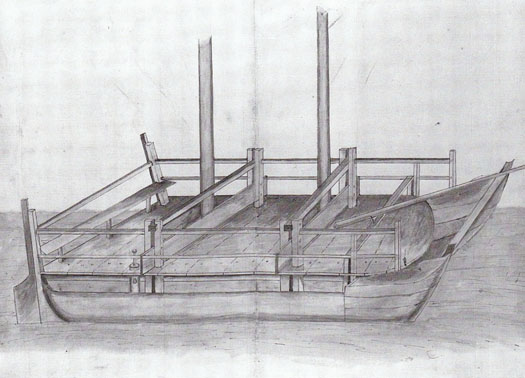
Contemporary drawing of the 17th Century catamaran Simon & Jude, which was built in Dublin and tested in the bay in an early "yacht race" in 1663.
We meanwhile are left wondering just what was this "pleasure boatte" was, and who owned and sailed it. Its existence and good sailing performance seems to have been accepted as unremarkable in Dublin Bay, yet no other record or mention of it has survived.
It was the turbulent life of Munster in the 17th Century which eventually created the conditions in which the first yacht club was finally formed. As the English Civil War spread to Ireland at mid-Century with a mixture of internecine struggle and conquest, the Irish campaigner Murrough O'Brien, the Sixth Baron Inchiquin, changed sides more than once, but made life disagreeable and dangerous for his opponents whatever happened to be the O'Brien side for the day.
Yet when the forces supporting Charles II got back on top in 1660 after the death of Cromwell in 1658, O'Brien was on the winning side. As the dust settled and the blood was washed away, he emerged as the newly-elevated Earl of Inchiquin, his seat at Rostellan Castle on the eastern end of Cork's magnificent natural harbour, and his interests including a taste for yachting acquired with his new VBF Charles II.
But there was much turmoil yet to come with the Williamite wars in Ireland at the end of the 17th Century. Yet somehow as the tide of conflict receded, there seemed to be more pleasure boats about Cork Harbour than anywhere else, and gradually their activities acquired a level of co-ordination. The first Earl of Inchiquin had understandably kept a fairly low profile once he got himself installed in his castle, but his descendants started getting out a bit and savouring the sea. So when the Water Club came into being in 1720, the fourth Earl of Inchiquin was the first Admiral.
In the spirit of the times, having an aristocrat as top man was sound thinking, but this was truly a club with most members described as "commoners", even if there was nothing common about their exceptional wealth and their vast land-holdings in the Cork Harbour area. Much of it was still most easily reached by boat, thus sailing passenger vessels and the new fancy yachts interacted dynamically to improve the performance of both.
Yet there was no racing. Rather, there was highly-organised Admiral Sailing in formation, something which required an advanced level of skill. However, many of the famous club rules still have a resonance today which gives the Water Club a sort of timeless modernity, and bears out the assertion by some historians that, as it all sprang to life so fully formed, the formation date of 1720 must be notional, as all the signs are that there had been a club of some sort for years beforehand.
But either way, it makes no difference to the validity or otherwise of the rival claim, that the Squadron of the Neva at St Petersburg in Russia, instituted by the Czar Peter the Great in 1718 to inculcate an enthusiasm for recreational sailing among Imperial Russia's young aristocrats, was the world's first yacht club. It was no such thing. It was in reality a unit of the Russian navy, and imposed by diktat from the all-powerful ruler. As such, it was entirely lacking the basic elements of a true club, which is a mutual organisation formed by and among equals.
Yet as the Water Club of the Harbour of Cork had no racing with results published in what then passed for the national media, we are reliant on the few existing club records and some travel writing from the time for much of our knowledge of the early days of the Water Club. That, and the Peter Monamy paintings of the Water Club fleet at sea in 1738.
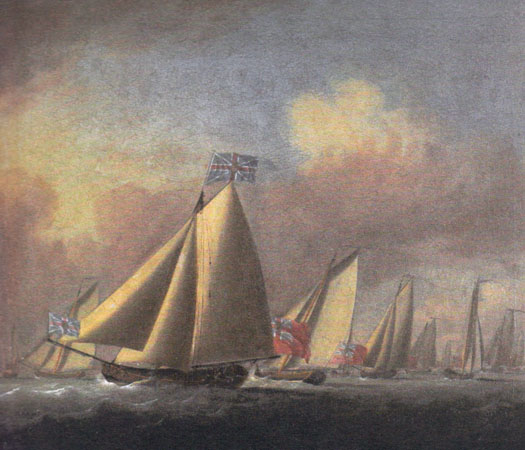
A remarkably well-disciplined fleet. Peter Monamy's 1738 painting of the yachts of the Water Club at sea off Cork Harbour. They weren't racing, but were keeping station in carefully-controlled "Admiral Sailing". Courtesy RCYC
Fortunate indeed are the sailors of Cork, that their predecessors' activities should have been so superbly recorded in these masterpieces of maritime art. The boats may look old-fashioned to a casual observer, yet there's something modern or perhaps timeless in this depiction of the fleet sailing in skilled close formation, and pointing remarkably high for gaff rigged boats as they turn to windward. Only a genuine shared enthusiasm for sailing could have resulted in such fleet precision, and in its turn in a memorable work of art. It is so much part of Irish sailing heritage that we might take it for granted, but it merits detailed study and admiration no matter how many times you've seen it already.
Shortly after Monamy's two paintings were completed, Ireland entered a period of freakish weather between 1739 and 1741 when the sun never shone, yet it seldom if ever rained, and it was exceptionally cold both winter and summer. It is estimated that, proportionately speaking, more people died in this little known famine than in the Great Famine itself 104 years later. While the members of the Water Club would have been personally insulated from the worst of it, the economic recession which struck an intensely agricultural area like Cork affected all levels of society.
Thus the old Water Club saw a reduction in activity, but though it revived by the late 1740s, the sheer energy and personal commitment of its early days was difficult to recapture, and by the 1760s it was becoming a shadow of its former self. Nevertheless there was a revival in 1765 and another artist, Nathanael Grogan, produced a noted painting of Tivoli across from Blackrock in the upper harbour, with a yacht of the Water Club getting under way for a day's recreation afloat, the imminent departure being signalled by the firing of a gun.
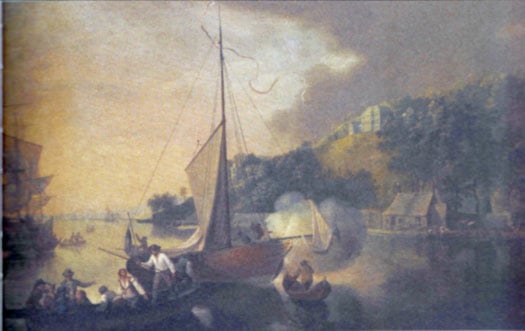
The best way to get the crew on board....on upper Cork Harbour at Tivoli in 1765, a yacht of the reviving Water Club fires a gun to signal imminent departure.
However, it was on Ireland's inland waterways that the next club appeared – Lough Ree Yacht Club came into being in 1770, and is still going strong. That same year, one of the earliest yacht clubs in England appeared at Starcross in Devon, but it was in London that the development pace was being most actively set with racing in the Thames for the Cumberland Fleet. Some members of this group, after the usual arguments and splits which plague any innovative organisation, in due course re-formed themselves as the Royal Thames Yacht Club in the early 1800s. But the famous yet unattributed painting of the Cumberland Fleet racing on the Thames in 1782, while it is slightly reminiscent of Monamy's painting of the Water Club 44 years earlier, undoubtedly shows boats racing. And they'd rules too – note the port tack boat on the right of the picture bearing off to give way to the boat on starboard.
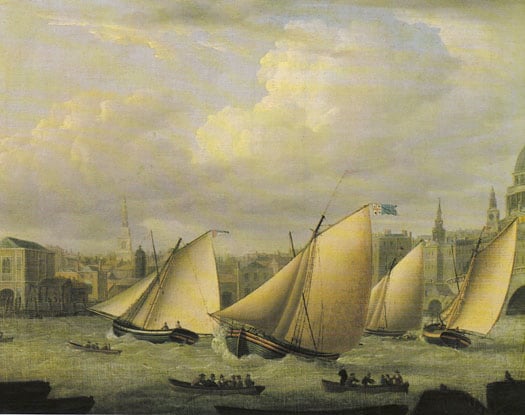
Definitely racing – the Cumberland Fleet, precursor of the Royal Thames Yacht Club, racing in the River Thames at Blackfriars in 1782.
The Thames was wider in those days, but even so they needed strict rules to make racing possible. Dublin Bay offered more immediate access to open water, and there were certainly sailing pleasure boats about. When the Viceroy officially opened the Grand Canal Dock on April 23rd 1796, it was reported that the Viceregal yacht Dorset was accompanied by a fleet of about twenty ceremonial barges and yachts. Tantalisingly, the official painting is almost entirely focused on the Dorset and her tender, while the craft in the background seem to be naval vessels or revenue cutters.
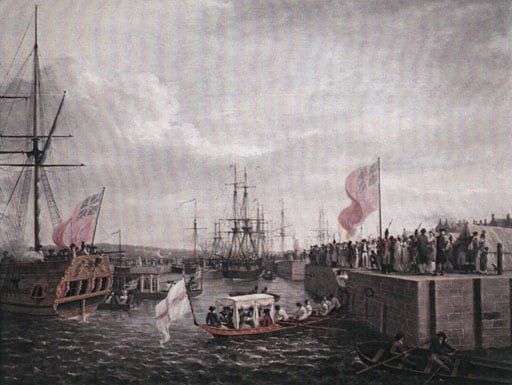
This painting of the opening of the Grand Canal Dock in 1796 tends to concentrate on the ceremonials around the Viceroy's yacht Dorset in the foreground, but fails to show clearly any of the several privately-owned yachts which were reportedly also present....
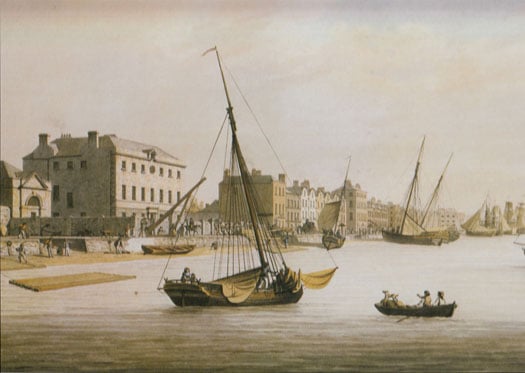
.......but this illustration of the old Marine School on the South Quays in Dublin in 1803 seems to have a yacht – complete with owner and his pet dog on the dinghy in the foreground – anchored at mid-river.
However, a Malton print of the Liffey in 1803 shows clearly what is surely a yacht, the light-hearted atmosphere of waterborne recreation being emphasised by the alert little terrier on the stern of the tender conveying its owner in the foreground Meanwhile in the north of Ireland there was plenty of sailing space in Belfast Lough, while Belfast was a centre of all sorts of innovation and advanced thinking. Henry Joy McCracken, executed for his role in the United Irishmen's rising in 1798, was a keen pioneer yachtsman. As things took a new turn of determined money-making in Belfast after the Act of Union of 1801, some of his former crewmates were among those who formed the Northern Yacht Club in 1824, though it later transferred its activities across the North Channel to the Firth of Clyde, and still exists as the Royal Northern & Clyde YC.
Meanwhile in 1806 the old Water Club of the Harbour of Cork had shown new signs of life, but one result of this was an eventual agreement among members - some of them very old indeed, some representing new blood - that the club would have to be re-structured and possibly even given a new name in order to reflect fresh developments in the sport of yachting. The changeover was a slow business, as it had to honour the club's history while giving the organisation contemporary relevance. Thus it was 1828 before the Royal Cork Yacht Club had emerged in this fully fledged new form, universally acknowledged as the continuation of the Water Club, and incorporating much of its style.
But it was across the north on Lough Erne in 1820 that the world's first yacht club specifically set up to organise racing was formed, and Lough Erne YC continues to prosper today, its alumnae since 1820 including early Olympic sailing medallists and other international champions.
There must have been something in the air in this northwest corner of Ireland in the 1820s, for in 1822 the men who sailed and raced boats on Lough Gill at Sligo had a pleasant surprise. Their womenfolk got together and raised a subscription for a handsome silver trophy to be known as the Ladies' Cup, to be raced for annually – and it still is.
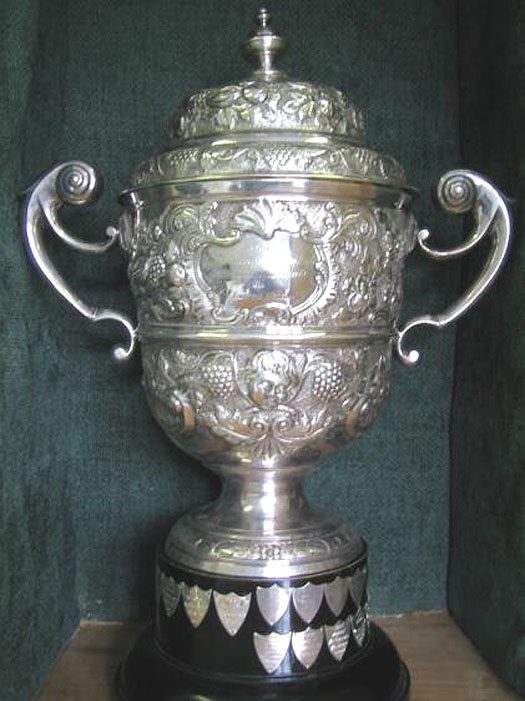
Instituted in 1822, the Ladies' Cup of Sligo YC is the world's oldest continually-contested annual sailing trophy.
Annual challenge cups now seem such a natural and central part of the sailing programme everywhere that it seems extraordinary that a group of enthusiastic wives, sisters, mothers and girlfriend in northwest Ireland were the first to think of it, yet such is the case. Or at least theirs is the one that has survived for 192 years, so its Bicentenary in 2022 is going to be something very special.
Those racing pioneers of the Cumberland Fleet had made do with new trophies freshly presented each year. And apparently the same was the case initially at Lough Erne. But not so very far down the road, at Sligo, somebody had this bright idea which today means that the museum in Sligo houses the world's oldest continually raced-for sailing trophy, and once a year it is taken down the road to the Sligo YC clubhouse at Rosses Point to be awarded to the latest winner – in 2013, it was the ever-enthusiastic Martin Reilly with his Half Tonner Harmony.
The Ladies Cup was won in 2013 by Martin Reilly's Half Tonner Harmony. Pictured with their extremely historic trophy are (left to right) Callum McLoughlin, Mark Armstrong, Martin Reilly, John Chambers, Elaine Farrell, Brian Raftery and Gilbert Henry
However, although the Ladies' Cup may have pioneered a worthwhile trend in yacht racing, it wasn't until 1831 that they thought of inscribing the name of the winner, and that honour goes to Owen Wynne of Hazelwood on the shores of Lough Gill. But by that time the notion of inscribing the winners was general for all trophies, and a noted piece of the collection in the Royal Cork is the Cork Harbour Regatta Cup 1829, and on it is inscribed the once-only winner, Caulfield Beamish's cutter Little Paddy.
The name of noted owner, skipper and amateur yacht designer Caulfield Beamish came up here some time back, when we were discussing how in 1831 he took a larger new yacht to his own design, the Paddy from Cork, to Belfast Lough where he won a stormy regatta. So you begin to understand the mysterious enthusiasm people have for sacred relics when you see this cup with its inscription, and realise that it's beyond all doubt that this now-forgotten yet brilliant pioneer of Cork Harbour sailing development personally held this piece of silverware.
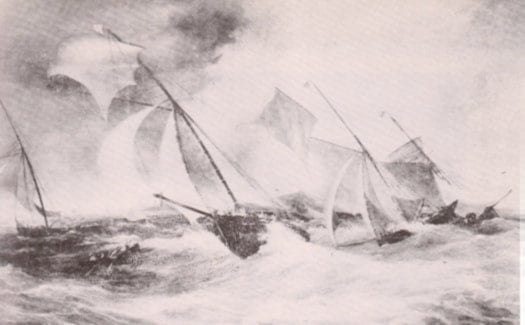
Caulfield Beamish's new cutter Paddy from Cork (which he designed himself) winning a stormy regatta in Belfast Lough in 1831
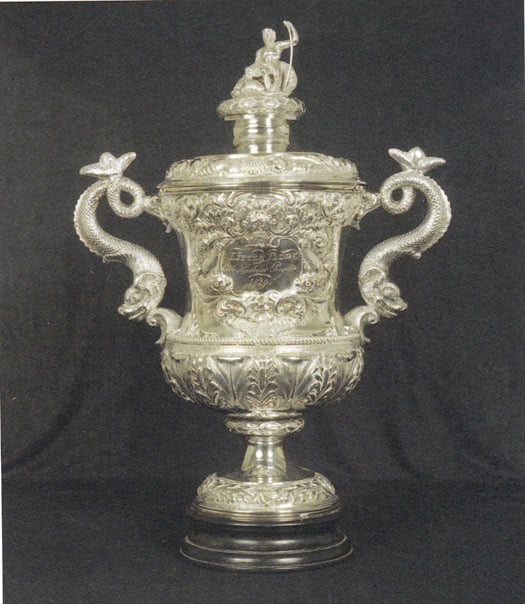
The Cork Harbour Regatta Cup of 1829.....Courtesy RCYC
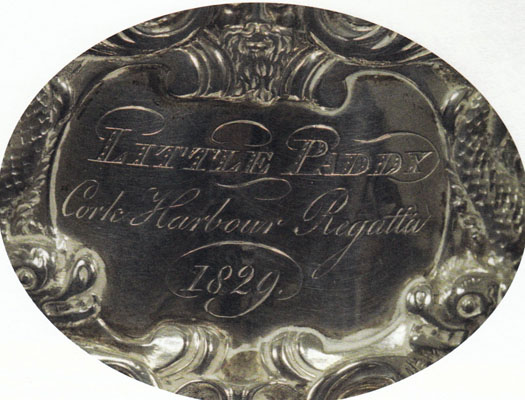
....and on it is inscribed the winner, Caulfield Beamish's earlier boat, Little Paddy, which he also designed himself. Courtesy RCYC
Another pioneer in yacht racing at the time was the Knight of Glin from the Shannon Estuary, who in 1834 was winning all about him with his cutter Rienvelle, his season's haul including a silver plate from a regatta in Galway Bay – it's now in Glin Castle – while he also seems to have relieved fellow Limerick owner William Piercy of £50 for a match race in Cork Harbour against the latter's cutter Paul Pry.
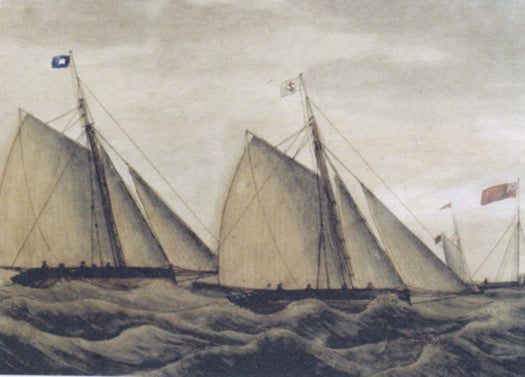
The lads from Limerick hit Cork. William Piercy's Paul Pry racing for a wager of £50 against the Knight of Glin's Rienvelle in Cork Harbour in 1834. When Paul Pry won Cork Harbour Regatta a few weeks later, the band on the Cobh waterfront played Garryowen. Courtesy RCYC
But of all the fabulous trophies in the Royal Cork collection, the one which surely engenders the most affection is the Kinsale Kettle. It goes back "only" to 1859, when it was originally the trophy put up for Kinsale Harbour Regatta. But this extraordinarily ornate piece of silverware was not only the trophy for an annual race, it was also the record of each race, as it's inscribed with brief accounts of the outcomes of those distant contests.
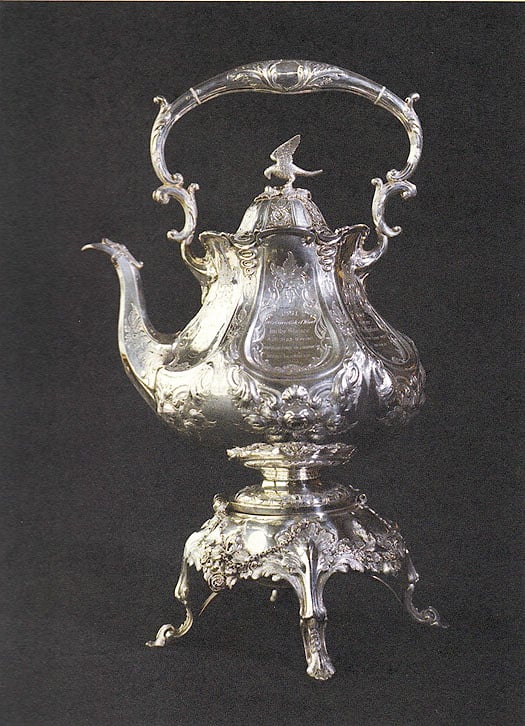
An extraordinary piece of Victorian silverware. The "Kinsale Kettle" from 1859 is now the Royal Cork YC's premier trophy.
Today, it continues to thrive as the Royal Cork Cup, the premier award for Cork Week. The most recent winner in 2012 was Piet Vroon with his superb and always enthusiastic Tonnere de Breskens. The fact that this splendid ambassador for Dutch sailing should be playing such a central role in current events afloat here in Ireland brings the story of our sport's artworks and historical artefacts to a very satisfactory and complete circle.
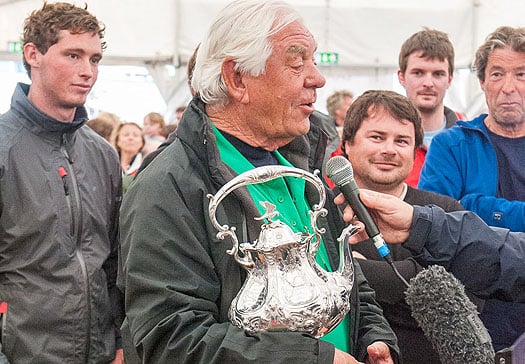
More tea, skipper? The current holder of the Kinsale Kettle, aka the Royal Cork Cup, is Piet Vroon of Tonnere de Breskens. Photo: Bob Bateman





























